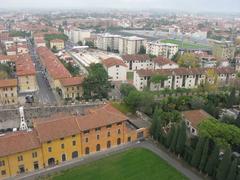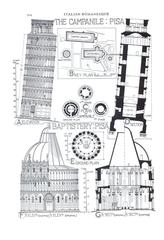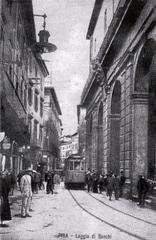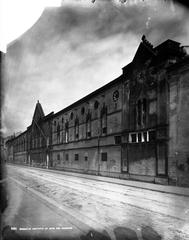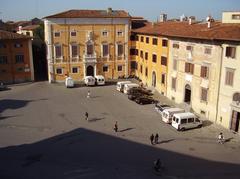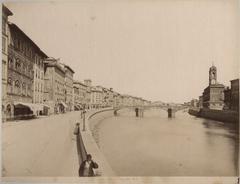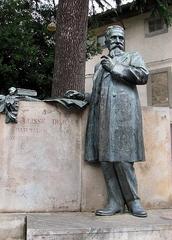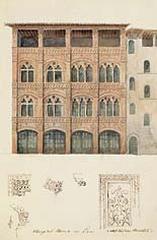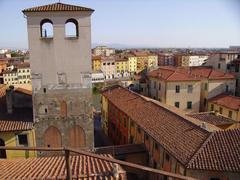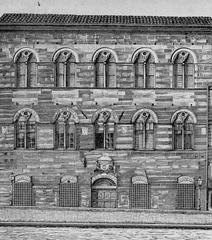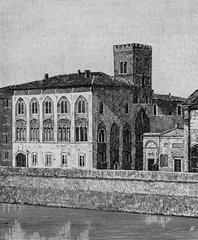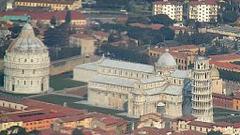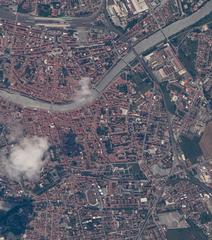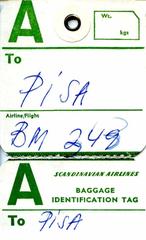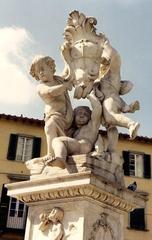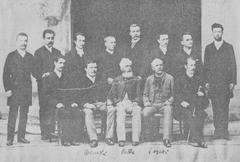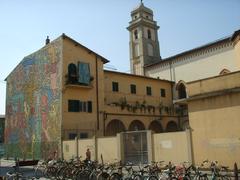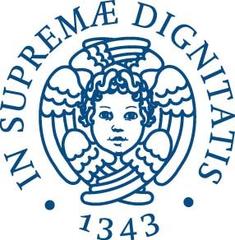War Memorial in Palazzo della Sapienza Pisa: Visiting Hours, Tickets, and Historical Significance
Date: 03/07/2025
Introduction
The Palazzo della Sapienza in Pisa, Italy, is a landmark that weaves together centuries of academic excellence, architectural splendor, and civic memory. Established in the 14th century and expanded during the Renaissance under Medici patronage, this historic building has long served as the intellectual nucleus of the University of Pisa. Within its elegant courtyards and frescoed halls lies the War Memorial—a solemn tribute to students, faculty, and citizens who sacrificed their lives in Italy’s wars. This detailed guide explores the Palazzo’s history, architectural highlights, the War Memorial’s significance, and provides practical information on visiting hours, tickets, accessibility, and nearby attractions. Whether you’re a history enthusiast, architecture devotee, or a traveler eager to understand Pisa’s cultural narrative, this article prepares you for a fulfilling visit to one of Pisa’s most meaningful historical sites. For the latest updates, consult the University of Pisa official website, Eternal Arrival, and Turismo Pisa.
Table of Contents
- Discovering Palazzo della Sapienza: A Historic Gem in Pisa
- Origins and Architectural Development
- The War Memorial: History and Significance
- Architectural Features and Artistic Heritage
- Cultural and Educational Impact
- Practical Visitor Information
- FAQ
- Conclusion and Visitor Tips
- References
Discovering Palazzo della Sapienza: A Historic Gem in Pisa
Situated in the heart of Pisa’s historic district, the Palazzo della Sapienza is a prime example of Renaissance civic architecture. Its central location places it within walking distance of iconic landmarks such as Piazza dei Cavalieri and the Leaning Tower. The Palazzo’s harmonious façades, arcaded courtyards, and richly decorated interior spaces embody the city’s academic and cultural legacy (Eternal Arrival).
Origins and Architectural Development
Founded in 1343 by papal decree, the Palazzo della Sapienza became the seat of the University of Pisa—a beacon of law, medicine, philosophy, and the sciences. The Medici family’s Renaissance expansions introduced the two-story loggia, decorative medallions, and a central courtyard that fostered scholarly gatherings and public ceremonies. The building showcases a blend of Quattrocento (15th-century) structure and later Cinquecento (16th-century) enhancements, attributed to architects like Giuliano da Sangallo (arpi.unipi.it). The main façade, constructed from local stone and brick, is marked by symmetry, proportion, and understated Renaissance ornamentation (urtrips.com).
The War Memorial: History and Significance
Historical Background
The War Memorial within the Palazzo della Sapienza commemorates members of the university community who perished during the World Wars and the Battle of Curtatone and Montanara (1848)—a key event in Italy’s unification. It is a longstanding Italian tradition to honor the fallen within educational institutions, and Pisa’s memorial stands as a powerful symbol of academic patriotism and civic remembrance (Meditari Pisa Conference Venue).
Artistic and Architectural Features
Prominently located near the main courtyard or corridors leading to the Aula Magna Storica, the memorial features marble plaques engraved with the names of the fallen, classical motifs such as columns and arches, and commemorative inscriptions. A bronze statue by Gigi Supino (1921) specifically honors those lost at Curtatone and Montanara, reinforcing the site’s academic-military connection. The memorial’s restrained style creates a reflective atmosphere, harmonizing with the Renaissance architecture around it (Turismo Pisa).
Cultural and Civic Importance
The memorial serves as a focal point for annual ceremonies—especially on National Unity and Armed Forces Day (November 4), Liberation Day (April 25), and the anniversary of Curtatone and Montanara (May 29). These gatherings unite university officials, students, and city dignitaries in remembrance, strengthening the bond between Pisa’s academic and civic identities.
Architectural Features and Artistic Heritage
Central Courtyard
The Palazzo’s quadrangular courtyard, surrounded by arcaded porticoes, is a masterpiece of Renaissance design. Stone paving, geometric decorations, and Medici heraldic emblems create an interplay of light and shadow, offering a tranquil setting for reflection and academic events (arpi.unipi.it).
Interior Spaces
The grand reception hall, used for ceremonies and lectures, boasts high ceilings, frescoes, and inscriptions celebrating academic achievements. The university library houses rare manuscripts and incunabula, while galleries display antique sculptures, paintings, and academic regalia. The Aula Magna features allegorical art symbolizing wisdom and justice (urtrips.com).
Integration with Urban Pisa
The Palazzo della Sapienza fits seamlessly into the historic urban fabric, next to landmarks like Piazza dei Cavalieri, the Leaning Tower, and the Arno River. Landscaped gardens and parks nearby further enrich the visitor experience (visititaly.com).
Cultural and Educational Impact
Beyond its architectural grandeur, the Palazzo della Sapienza remains a vibrant academic and cultural venue. The War Memorial supports the university’s mission—professors incorporate visits into history and civic education courses, and local schools and heritage tours frequently include the site. Annual commemorations and public events further anchor the memorial’s role in Pisa’s collective memory.
Practical Visitor Information
Location
- Address: Via Curtatone e Montanara, 15, 56126 Pisa, Italy
- Centrally located in Pisa’s historic district, close to major attractions (Google Maps).
Visiting Hours
- General Palazzo Opening: Monday to Friday, 9:00 AM – 6:00 PM; some areas may have different schedules.
- War Memorial and Courtyard: Monday–Wednesday, 9:30 AM – 5:30 PM; Thursday–Friday, 9:30 AM – 1:30 PM; closed on weekends.
- Note: Hours may vary during university events, holidays, or maintenance. Always check the official website before visiting.
Tickets and Admission
- Entry Fee: Free for the courtyard and War Memorial. Special exhibitions or guided tours may require tickets (€5–€10).
- Booking: Tickets for exhibitions or tours can be purchased online or at the entrance.
Accessibility
- The courtyard and main entrance are wheelchair accessible. Some historic areas may have steps or uneven surfaces. For specific needs, contact the university or tourist office in advance (Wikipedia IT).
Guided Tours and Special Events
- Guided tours are available during university open days, cultural events, or by appointment. Tours often cover the palace’s architectural, academic, and memorial features.
- Ceremonies are held on key dates, providing unique opportunities to witness Pisa’s traditions.
Nearby Attractions
- Piazza dei Cavalieri: 230 m
- Botanical Gardens: 380 m
- Royal Palace: 250 m
- Chiesa di San Frediano: 70 m
- Enjoy local cafes and restaurants for a complete day in Pisa (Terre di Pisa).
Frequently Asked Questions (FAQ)
Q: What are the Palazzo della Sapienza visiting hours?
A: Generally Monday to Friday, 9:00 AM – 6:00 PM. The War Memorial is open Monday–Wednesday, 9:30 AM – 5:30 PM, and Thursday–Friday, 9:30 AM – 1:30 PM. Always check the official website for updates.
Q: Is admission free?
A: Yes, entry to the courtyard and War Memorial is free. Special exhibitions or guided tours may have a fee.
Q: Are guided tours available?
A: Yes, during special events or by prior arrangement. Check with the Tourist Office Pisa for details.
Q: Is the site accessible for visitors with disabilities?
A: Main areas are accessible; some historic rooms may have limited access.
Q: Can I take photographs?
A: Yes, non-flash photography is permitted. Professional photography requires prior approval.
Q: Are there special events or ceremonies?
A: Ceremonies are held on May 29 (Curtatone and Montanara), November 4 (National Unity Day), and April 25 (Liberation Day).
Conclusion and Visitor Tips
The War Memorial at Palazzo della Sapienza is more than a historical site—it is a living testament to Pisa’s academic and civic values. Visitors can reflect on the sacrifices of past generations, appreciate Renaissance architecture, and explore the vibrant academic life of the University of Pisa. Plan your visit during commemorative events for a deeper cultural experience, and combine your tour with other nearby attractions for a comprehensive exploration of Pisa’s heritage.
Call to Action:
Enhance your Pisa experience by downloading the Audiala app for curated walking tours, real-time updates, and exclusive insights. Follow us on social media for stories, tips, and the latest cultural highlights from Pisa.
References
- ‘Palazzo della Sapienza in Pisa: History, Architecture, Visiting Hours, and Tips for Tourists’, Eternal Arrival, 2025 (eternalarrival.com)
- ‘Visiting the Palazzo della Sapienza War Memorial: History, Significance & Visitor Guide’, Meditari Pisa Conference Venue, 2025 (meditaripisa2025.ec.unipi.it)
- ‘Palazzo della Sapienza Pisa: Visiting Hours, Tickets, and Historical Insights’, UR Trips and ARPI University of Pisa Archives, 2025 (urtrips.com), (arpi.unipi.it)
- ‘War Memorial Palazzo della Sapienza Pisa Visiting Hours, Tickets, and Visitor Guide’, Turismo Pisa and Terre di Pisa, 2025 (turismo.pisa.it), (terredipisa.it)
- ‘Pisa City Guide’, Renato Prosciutto, 2025 (renatoprosciutto.com)
